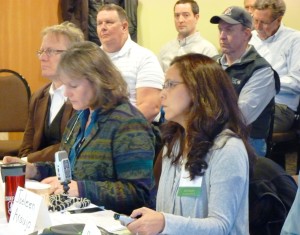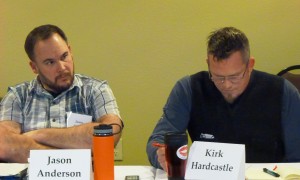
Sealaska Vice President and General Counsel Jaeleen Araujo, front right, describes Tongass land being transferred to the regional Native corporation under terms of recently-passed legislation. (Ed Schoenfeld/CoastAlaska News)
Sealaska says it will begin logging its new lands later this year.
Federal legislation passed in December turned over 70,000 acres of the Tongass National Forest to Southeast Alaska’s regional Native corporation.
The first two parcels to be cut will be on north Election Creek, on Prince of Wales Island, and the Cleveland Peninsula, north of Ketchikan.
They add up to about 3,400 acres of old-growth forest near land Sealaska’s already logged.
“And those are smaller, but they’re adjacent to some existing operations. So those will probably be the two areas that would see activity first,” says Sealaska General Counsel Jaeleen Araujo, who discussed the plans at the recent Tongass Advisory Committee meeting in Juneau.
Audio PlayerThe 15-member panel is helping craft the Tongass’ transition from old- to young-growth logging.
Almost all of Sealaska’s Tongass acreage is timber land, split into nine sites, most on or near Prince of Wales Island.
Older forests make up more than half that acreage. About a third is growing back from previous cuts under Forest Service management.
“I was not of the opinion that legislation was going to go forward,” says Forrest Cole, the Tongass National Forest’s top official.

Jason Anderson of the Forest Service and fisheries business owner Kirk Hardcastle listen to a presentation during a Tongass Advisory Committee meeting at Juneau’s Aspen Hotel. (Ed Schoenfeld/CoastAlaska News)
While the Forest Service agreed to the legislation, its passage altered timber sale plans, including on an island off Prince of Wales’ west coast.
“So we basically started a fairly large project on Kosciusko (Island). And now that Sealaska’s happened, we’re going to have to take some of that project out and see if we can pick it up elsewhere on the island,” he says.
Cole says the sale should be planned out by mid-summer. It’s near the community of Edna Bay, which opposed Sealaska’s takeover of the forest lands. A large state timber sale is also planned there.
Araujo says the corporation’s new Kosciusko land, plus additional acreage on nearby Tuxecan Island, contain the largest stands of its new, second-growth timber.
Once the legislation takes full effect, Sealaska will become the state’s largest timber company, by far.
Araujo says it understands its role in the regional economy is changing.
“Obviously, we do provide a benefit to our shareholders, but we also benefit a lot of local businesses where we operate. And a number of contractors do depend on us,” she says.
Southeast Alaska’s timber industry lobbied for the land transfers.
Alcan Forest Products owner Eric Nichols, a Tongass Advisory Committee member, says Sealaska logging will help preserve existing markets.
“It also helps support the infrastructure that’s out there in non-logging: float planes, barges, scaling companies. So all these people now have a little bit better degree of certainty. And hopefully we’ll quit losing so much of our infrastructure that helps support the forest industry here in Southeast,” Nichols says.
Critics say the land transfer is a mistake.
“Anytime our public lands are taken out of public hands, it’s a cause for concern for everybody across the country,” says Andrew Thoms, executive director of the Sitka Conservation Society and another advisory committee member.
He hopes Sealaska will sell its timber to regional mills. Now, it’s stripped of branches and sold as logs, mostly overseas.
“The old-growth resource that we have on the Tongass is limited. And it’s a shame when we see it exported overseas in the round without any processing or manufacturing in the region. And once that old-growth resource is gone, it’s gone,” he says.
Sealaska cites a study showing its log-preparation work provides jobs to about as many people as processing in mills.
But Araujo says it will look harder at in-state sales, forest restoration and other issues that come with taking over 70,000 acres of the Tongass.
“Our board wants to better understand mitigation, wants to better understand domestic processing, wants to better understand how we can maybe become our own contractor. There’s just a lot of things that we’re looking at now that this has happened,” she says.
Almost 98 percent of the acreage being transferred is timberland. About 1.5 percent is for other economic development, including energy production. The remainder includes about 75 cemetery and historic sites.
More responses to the Tongass transition are available online:
- Read a summary of public comments submitted to the advisory committee.
- Read comments, organized by month submitted.










